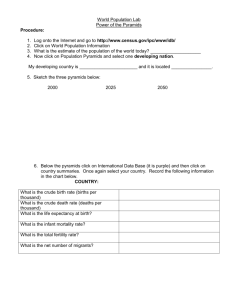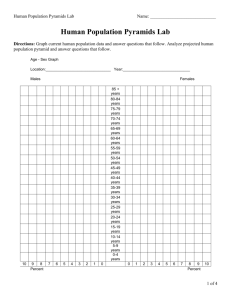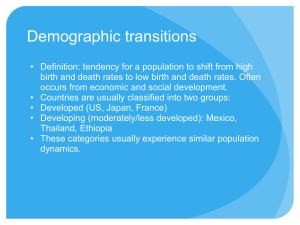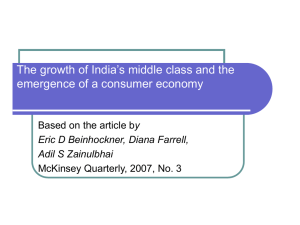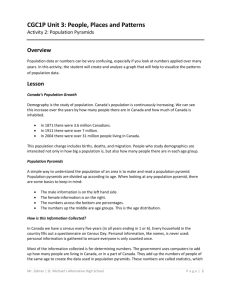Population Pyramids
advertisement
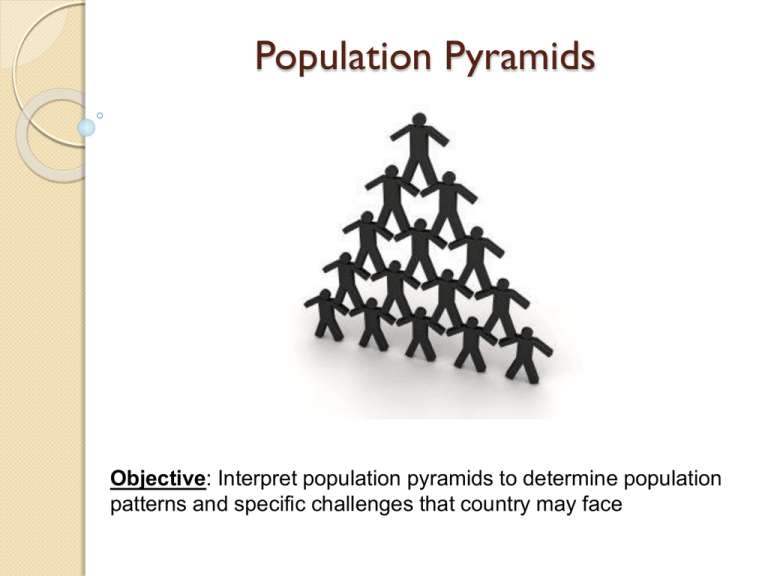
Population Pyramids Objective: Interpret population pyramids to determine population patterns and specific challenges that country may face Population Pyramids A population pyramid, also known as an age-sex pyramid, is a graphical illustration that shows the distribution of various age groups in a population (typically that of a country or region of the world), which normally forms the shape of a pyramid. Age Distribution of the World’s Population Population Structures by Age and Sex, 2005 Millions Less Developed Regions More Developed Regions Age Male 300 200 100 Female 0 100 200 300 80+ 75-79 70-74 65-69 60-64 55-59 50-54 45-49 40-44 35-39 30-34 25-29 20-24 15-19 10-14 5-9 0-4 Male 300 100 Source: United Nations, World Population Prospects: The 2004 Revision, 2005. Female 100 300 Notes on Age Distribution of the World’s Population • Sex and age distributions show that less developed countries have significantly younger populations than more developed countries. • Almost one-third of the population in less developed countries is under age 15. In contrast, less than one-fifth of the population in more developed countries is under 15. • Today there are more than 2 billion young people below age 20 in less developed regions—the age cohort that will soon become the world’s newest group of parents. • Young age structures in the less developed countries are due mainly to higher levels of childbearing in recent decades. Trends in Aging, by World Region Population Ages 65 and Older Percent 21 14 11 10 7 6 3 World 10 6 4 Africa Asia 2000 Latin America and the Caribbean 2025 Source: United Nations, World Population Prospects: The 2004 Revision (medium scenario), 2005. More Developed Regions Notes on Trends in Aging, by World Region • By 2025, over 20 percent of the population in more developed regions will be ages 65 and older. • By 2025, one-tenth of the world’s population will be over age 65. • Asia will see the proportion of its elderly population almost double, from about 6 percent in 2000 to 10 percent in 2025. In absolute terms, this represents a stark increase in just 25 years: from about 216 million to about 480 million older people. Dependency Ratio •# of people who are too young or too old to work, compared to the number of people in their productive years •Larger percentages of dependents = greater financial burden for the working population Dependency Ratios for Selected Countries United States China France Indonesia Vietnam Bangladesh Nepal Nigeria .52 .49 .52 .63 .75 .72 .81 .88 US Population (2000) About Current Estimates: Women Slightly Larger US Population (2025) 2025 Estimates: Women Slightly Larger (esp: Older aged) US Population (2050) 2050 Estimates: Women Larger Elderly Gap Mexico Canada THE END…. information source: International Data Base, U.S. Census Bureau; applied pyramids were modified using Canvas, GraphicConverter and GIFBuilder. See other countries age


